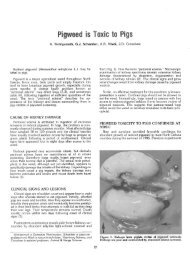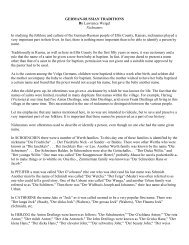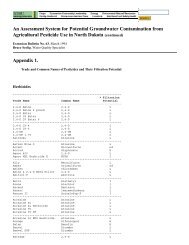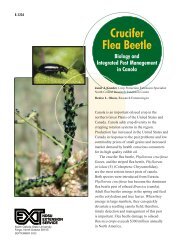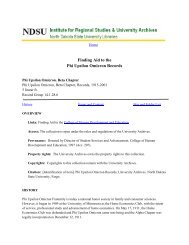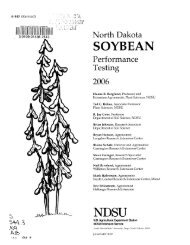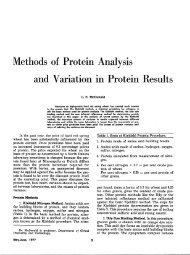germans from russia in fort collins, 1900-2000 - Libraries
germans from russia in fort collins, 1900-2000 - Libraries
germans from russia in fort collins, 1900-2000 - Libraries
You also want an ePaper? Increase the reach of your titles
YUMPU automatically turns print PDFs into web optimized ePapers that Google loves.
WORK RENDERS LIFE SWEET: GERMANS FROM RUSSIA IN FORT COLLINS<br />
lar shanties throughout northern Colorado,<br />
particularly the example preserved at the<br />
Greeley Museum. This beet shanty measures<br />
twenty-four-by-fourteen feet, features five<br />
small, square w<strong>in</strong>dows, and has a rounded<br />
roof. The shanties <strong>in</strong> Buck<strong>in</strong>gham were most<br />
likely framed with two-by-four-<strong>in</strong>ch or twoby-six-<strong>in</strong>ch<br />
studs spaced a foot apart. Wide,<br />
rough-hewn planks were then nailed to this<br />
frame. Tarpaper secured with vertical furr<strong>in</strong>g<br />
strips clad the exterior walls. W<strong>in</strong>dows were<br />
almost always four-light fixed or casement<br />
and fenestration varied with the arrangement<br />
of rooms <strong>in</strong>side. Red or black felt covered the<br />
roof of the structure and provided all of the<br />
<strong>in</strong>sulation. This roof<strong>in</strong>g was also secured with<br />
furr<strong>in</strong>g strips, which ran perpendicular to the<br />
eaves. A short, round stovepipe emerged near<br />
the crest of the roof. Interest<strong>in</strong>gly, a house of<br />
similar form and proportion still exists at 240<br />
Third Avenue <strong>in</strong> Fort Coll<strong>in</strong>s. Photos of the<br />
1904 flood also show side-gabled shanties of<br />
similar dimensions and identical w<strong>in</strong>dows.<br />
They are sheathed <strong>in</strong> vertical, board-and-batten<br />
sid<strong>in</strong>g. 53 Inside, most shanties were one or<br />
two rooms, a rather ancient hall-and-parlor<br />
division of corporate space. Larger, more permanent<br />
shanties conta<strong>in</strong>ed an actual division<br />
between rooms, while suspended blankets<br />
divid<strong>in</strong>g sleep<strong>in</strong>g <strong>from</strong> liv<strong>in</strong>g and cook<strong>in</strong>g<br />
areas of smaller structures. 54<br />
The <strong>in</strong>teriors of these t<strong>in</strong>y houses must<br />
have seemed <strong>in</strong>humanly cramped to outsiders.<br />
But histories of German settlements <strong>in</strong><br />
Russia and oral histories of those German-<br />
Russian who came to the United States reveal<br />
a long history of high-density liv<strong>in</strong>g.<br />
Kather<strong>in</strong>e Elizabeth Blehm was born <strong>in</strong><br />
Seraco, Russia, <strong>in</strong> 1895, and spent much of<br />
her life <strong>in</strong> Fort Coll<strong>in</strong>s. She recalled that <strong>in</strong><br />
Russia, thirteen people resided <strong>in</strong> her family’s<br />
three-room house. 55 German-Russian families<br />
<strong>in</strong> Russia and the United States often<br />
slept crossways on mattresses to economize<br />
space and conserve body heat <strong>in</strong> the poorly<br />
<strong>in</strong>sulated and heated structures. Even <strong>in</strong> 1924,<br />
about seventy small structures <strong>in</strong><br />
Buck<strong>in</strong>gham housed 500 German-Russians.<br />
Each house averaged a little over seven residents.<br />
56<br />
The situation was a bit different <strong>in</strong><br />
Andersonville. There, the Fort Coll<strong>in</strong>s<br />
Colorado Sugar Company did not supply the<br />
houses. Instead, German-Russian families<br />
alone or with the help of a farm owner purchased<br />
the lots and built houses on them.<br />
These structures tended to be larger and more<br />
architecturally sophisticated than those <strong>in</strong><br />
Buck<strong>in</strong>gham. A 1904 photograph shows<br />
N<strong>in</strong>th Street look<strong>in</strong>g north <strong>from</strong> what is now<br />
San Cristo Street. Of the three houses clearly<br />
visible, two are rather complex cottages with<br />
muted, late-Victorian decorative elements.<br />
One features scroll-cut crest<strong>in</strong>g on its <strong>in</strong>tersect<strong>in</strong>g-gable<br />
roof, and the other has a bracketed,<br />
protrud<strong>in</strong>g bay w<strong>in</strong>dow. With vertical<br />
board-and-batten sid<strong>in</strong>g and simple, square<br />
porch supports, the third house lacks the decorative<br />
elements of the others, but it is still<br />
notably larger than the standard beet shanty <strong>in</strong><br />
Buck<strong>in</strong>gham. This may answer why<br />
Andersonville, despite hav<strong>in</strong>g a smaller population,<br />
was the first German-Russian neighborhood<br />
to construct a church and school; the<br />
residents may have been more affluent. Also<br />
tell<strong>in</strong>g are the differences <strong>in</strong> architectural<br />
sophistication and house size between<br />
Andersonville and Buck<strong>in</strong>gham as well as<br />
before and after the flood <strong>in</strong> both neighborhoods.<br />
Left to their own devices, Germans<br />
<strong>from</strong> Russia constructed more elaborate<br />
houses than the sugar company or farmers<br />
provided to them. 57<br />
Domestic architectural details specific to<br />
Germans <strong>from</strong> Russia are difficult to determ<strong>in</strong>e.<br />
In his 1970 study of German-Russian<br />
SWCA Environmental Consultants Page 15



